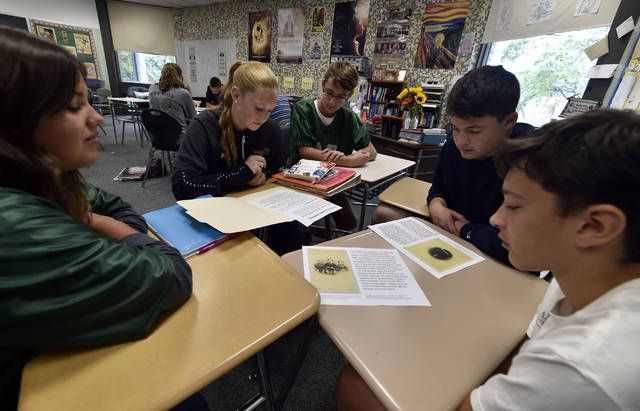Click here to subscribe today or Login.
EXETER — Dallas Woodruff stared at the picture of dead soldiers lined on the ground after the Battle of Antietam, and explained why she found it so compelling to see them so arranged: “It’s like, when they die, they’re not people anymore.”
Woodruff, a ninth grade student, was participating in a workshop with young adult novelist Matthew Landis, who spent Friday at the Wyoming Area Secondary Center meeting students in large and small groups, holding a variety of workshops.
This one was about how the graphic and detailed photos taken during the Civil War by Matthew Brady and James Gardner changed the country. A self-described Civil War “nerd,” Landis writes from his experience teaching social studies in a Bucks County middle school, and one of his novels — The Not So Boring Letters of Private Nobody — relates the evolving friendships of seventh grade students as they research a soldier who died of illness before fighting a single battle.
Woodruff conceded she has long had a fascination with death, after a fashion. “I used to go to the cemetery and get the names from tombstones and write stories about them,” she said, adding with a small smile, because I was that kid.”
Landis broke the students into four groups. One studied photos of the Antietam aftermath — including the dozens of bodies gathered and awaiting interment that evoked Woodruff’s comments. Another looked at pictures of Abraham Lincoln at different stages of his political career, a third at photos of dead Confederate soldiers at Gettysburg where some believe the photographers positioned the bodies, and a fourth at examples of cartes de visite, small pictures of people mounted on a card, typically only 2 inches by 3 inches or so in size.
Landis used each group of photos to raise issues. The Antietam ones, he noted, showed how “photography brought the bodies to our doorstep” for the first time in history. They were so detailed it was easy to imagine a person recognizing the face of a dead brother.
The Lincoln photos showed the fabled president at the launch of his campaign, when he reportedly thanked Brady for making him look presidential rather than “like a country hick,” and one taken about two months before his assassination, which Landis said could be construed as showing the stress the war had put on him.
The Gettysburg photos were of lone Confederate soldiers, dead, their rifles nearby — believed to be cases where the corpses were positioned for greater visual effect. He showed the captions the photographers used in books they published: “… his suffering must have been intense. Was he delirious with agony, or did death come slowly to his relief, while memories of home grew dearer as the field of carnage faded before him?”
“That’s getting Shakespearean,” Landis said, noting most photojournalists these days would not “editorialize” so much, yet also noting how powerful the language was next to the photos.
One of the last photos Landis focused on was of three children on a cartes de visite. It was found by a doctor working his way through the bodies on a battlefield, in the hand of one of the soldiers.
“To his dying moment, he wanted to have his family with him,” Landis said, “And photography made that possible.”







